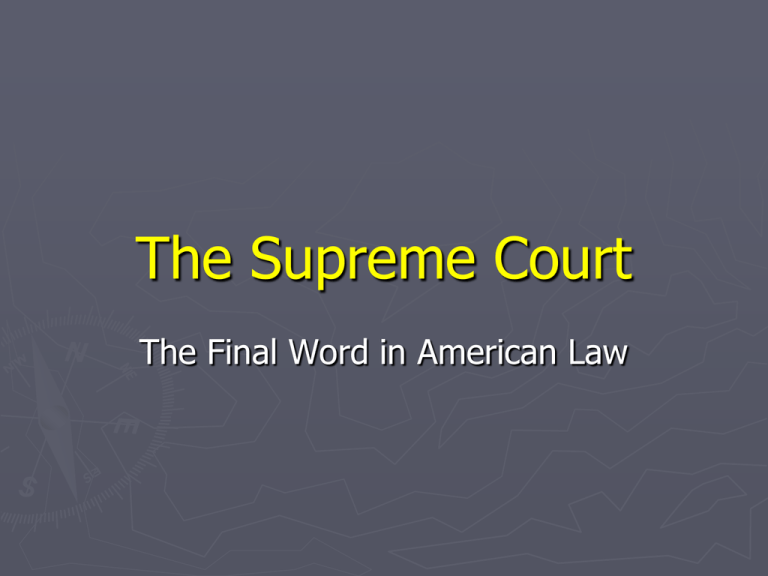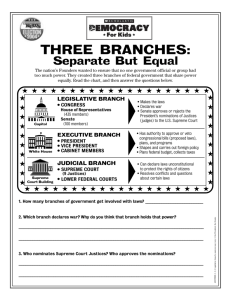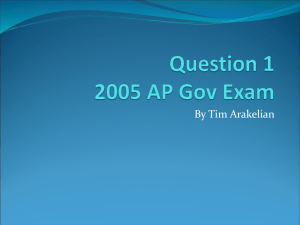The Supreme Court - Methacton School District
advertisement

The Supreme Court The Final Word in American Law What is the Supreme Court? The Supreme Court is the highest court in the U.S. ► It has final authority in all cases involving the Constitution, (Marbury v Madison) acts of Congress, acts of the Executive Branch, and treaties with other nations. ► How does the Supreme Court get it’s cases? ► Most cases have been passed through either the lower federal courts or have gone through the upper levels of the state courts (though it can only rule on federal laws, not state law). ► Some cases, those involving representatives from foreign governments or those involving state governments, can be first heard in the Supreme Court. ► The Supreme Court picks that cases that it wants to hear, it is not obligated to listen to all of the cases that are appealed to it. How does the Court rule? ► The court rules on how the nine justices interpret what the Constitution states. ► What judicial philosophies come into place? ► Strict Constructionists vs. Loose Constructionists ► More liberal judges tend to be loose constructionists. ► More conservative judges tend to be strict constructionists. Who sits on the Supreme Court? Sonia Sotomayer (2009) ► Antonio Scalia (1986) ► Anthony Kennedy (1988) ► Elena Kagen (2010) ► Clarence Thomas (1991) ► Ruth Bader Ginsburg (1993) ► Stephen Breyer (1994) ► John Roberts (2005) ► Samuel Alito (2006) ► U.S. Supreme Court Today ► Chief Justice John Roberts, Jr. ► Associate Justices: • ANTONIN SCALIA • ANTHONY M. KENNEDY • CLARENCE THOMAS • RUTH BADER GINSBURG • STEPHEN G. BREYER • SAMUEL A. ALITO, JR. • SONIA SOTOMAYOR • ELENA KAGAN What do the justices do? ► ► ► ► The Constitution does not define what the Court does, unlike the President and Congress. #1 – They decide which cases that they will hear argued. #2 – They decide the outcome of the cases. #3 – They write opinions either agreeing or disagreeing with the decision of the Court. Appointing Justices ► ► ► ► The President appoints a justice to the Supreme Court. The Senate must approve all of the President’s nominees. Justices are appointed for life. Why? So that they do not have to campaign or have their decisions altered by outside influences. Judicial Selection The Roberts Court, 2010 Back row (left to right): Sonia Sotomayor, Stephen G. Breyer, Samuel A. Alito, and Elena Kagan. Front row (left to right): Clarence Thomas, Antonin Scalia, Chief Justice John G. Roberts, Anthony Kennedy, and Ruth Bader Ginsburg Judicial Selection ► ► No formal qualifications for federal judges Federal judges serve “during good behavior”, which generally means for life • Why? – allows judges to be free from political pressures when deciding cases (don’t have to worry about being re-elected) ► May be removed from office through impeachment and conviction • 12 federal judges impeached – 7 found guilty and removed Judicial Selection: Lower Courts ► ► ► President has little to do with choosing Due to large # of appointments, the Department of Justice and the White House staff handle most of these nominations Senatorial Courtesy: allowing senators from president’s party who represents the state with the vacancy to approve or disapprove nominees Judicial Selection: Supreme Court ► ► President gives more attention to nominations to Supreme Court (higher visibility and importance) When making appointments, presidents often consider: • Party affiliation – chooses judges from their pol.party • Judicial philosophy – chooses judges who share their political ideology • Race, gender, religion, region • Judicial experience – previous experience as judge or attorney • “litmus test” – chooses a judge based on their view on 1 single issue (ex. Abortion) • Acceptability – chooses a judge who is non-controversial and will be easily confirmed by the Senate Background of Supreme Court Judges ► ► Almost all federal judges have • Had legal training • Held positions in government • Served as lawyers for leading law firms • Served as federal district attorney • Served as law school professors Few African-Americans, Hispanics, or Women ► President Lyndon B. Johnson appointed first African American Supreme Court Justice, Thurgood Marshall ► President Ronald Reagan appointed the first female Supreme Court Justice, Sandra Day O’Connor The Supreme Court At Work ► When is the Supreme Court in session? • Term of the Supreme Court begins on the first Monday in Oct. and generally lasts until June or July of the following year The Supreme Court At Work ► How does the Supreme Court accept a case to review? • Thousands of cases are appealed to the Supreme Court every year- only a few hundred are actually heard • Most cases denied because 1.) Justices agree with the lower court decision 2.) Justices believe the case does not involve a significant point of law • Cases that are accepted must meet the rule of four • Four of the nine justices must agree to hear the case • Many of the cases accepted may be disposed of in brief orders • Returned to the lower court for reconsideration because of a related case which was recently decided • Cases presented to the Supreme Court may be presented through 1.) Writ of Certiorari – an order by the Court (when petitioned) directing a lower court to send up records of a case for review 2.)Certificate – a lower court asks the Supreme Court about a rule of law or procedures in specific cases Briefs and Oral Arguments ► Once a case reaches the Supreme Court, lawyers for each party file a written brief • A detailed statement of the facts of the case supporting a particular position by presenting arguments based on relevant facts and citations from previous cases ► Oral arguments allow both sides to present their positions to the justices during a 30 minute period • Justices may interrupt lawyers during this time, raising questions or challenging points of law Writing Opinions ► ► ► Supreme Court decisions are explained in a written statement called an opinion If voting with the majority, the chief justice selects who will write the opinion If voting with the minority, the most senior associate justice of the majority selects who will write the opinion Writing Opinions 3 Types of Opinions: 1.) Majority Opinion – opinion agreed upon by a majority of the justices 2.) Concurring Opinion – written by a justice or justices who agree with the majority opinion, but not with the reasoning behind the decision 3.) Dissenting Opinion – written by a justices or justices who disagree with the majority opinion ► Majority opinion become precedents • Standards or guides to be followed in deciding similar cases in the future • Ex. Roe v. Wade (abortion), Mapp v. Ohio (exclusionary rule) Supreme Courts Through History Warren Court (1953-1969) ► Led by Chief Justice Earl Warren ► Often said to be the “most liberal court ever” ► Important cases decided • Brown v. Board of Education (1954) – ended segregation in public schools • Gideon v. Wainwright (1963) – states required to provide attorneys for those accused of a crime • Miranda v. Arizona (1966) – police have to inform anyone questioned of their rights in order to use the information in court Supreme Courts Through History Burger Court (1969-1986) ► Led by Chief Justice Warren Burger ► Returned the Supreme Court to a more conservative ideology ► Appointed by Richard Nixon ► Important cases decided: • Roe v. Wade (1973) – declared abortions legal with special time constraints • U.S. v. Nixon (1974) – ruled that President Nixon’s private recordings were not protected under presidential privilege and ordered them be turned over to the house investigators Supreme Courts Through History Rehnquist Court (1986-2005) ► Led by Chief Justice William Rehnquist ► Conservative court that continued to limit, but not reverse, decisions of earlier more liberal courts in the areas of defendant’s rights, abortion, and affirmative action ► Important cases decided • Planned Parenthood v. Casey (1992) – upheld and ruled constitutional a Pennsylvania law requiring a minor to wait 24 hours after receiving parental approval before getting an abortion – but ruled unconstitutional a provision that required a woman to obtain “informed spousal consent” before having an abortion • Roper v. Simmons (2004) –declared that the death penalty was unconstitutional for anyone under the age of 18 Judicial Philosophy 2 Types: 1.) Judicial Activism The court should play a more active role in creating national policies and answering questions of conflict in society 2.) Judicial Restraint The court should operate strictly within the limits of the Constitution and only answer questions if a clear violation of the Constitution is present. Policy making should be left up to the executive and legislative branches.








